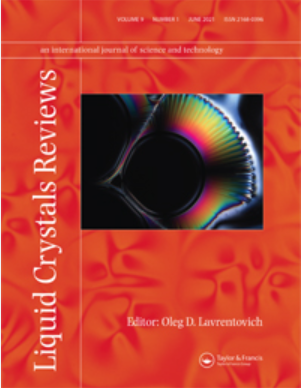近晶液晶薄膜中的一维图案和拓扑缺陷
IF 4.2
3区 材料科学
Q2 CHEMISTRY, PHYSICAL
引用次数: 3
摘要
. 近晶液晶显示出一种非凡的能力,可以自组织成各种纹理、图案和阵列,并以微尺度的周期性延伸到大的表面区域。这些结构为微器件和功能材料(如微透镜阵列和纳米颗粒模板)的自下而上制造提供了一个有用的平台。周期性结构的出现是由于外场(如薄膜界面上的混合(平面同向)锚定条件或垂直于表面锚定方向的电场)在近晶膜内产生的指向性对齐冲突而产生的。在这篇文章中,我们回顾了在薄膜中单向混合锚定条件或外加电场的作用下,由导向器弯曲引起的一维(1d)图案的形成、结构和应用。与焦点圆锥的晶格相比,一维模式具有不同寻常的拓扑缺陷阵列,包括偏斜和位错线,晶界和曲率壁,沿着周期性间隔和无弯曲的近晶层圆柱形堆叠运行。这些缺陷,其中大部分已经被Maurice Kleman描述过,似乎驱动了一维模式的结构演变,作为薄膜厚度的函数。在单向混合锚固下,缺陷垂直于平面锚固方向,为构建有序的密排纳米颗粒网络提供了高度各向异性的模板。此外,从向列相过渡到近晶相时的阵列形成与弯曲畸变引起的近晶相挫折密切相关,通过过冷的向列畴产生弯曲畸变部分穿透的“中间”近晶相本文章由计算机程序翻译,如有差异,请以英文原文为准。
One-dimensional patterns and topological defects in smectic liquid crystal films
. Smectic liquid crystals exhibit a remarkable ability to self-organize into a variety of textures, patterns, and arrays extending over large surface areas with microscale periodicity. These structures provide a useful platform for the bottom-up fabrication of microdevices and functional materials, such as microlens arrays and nanoparticle templates. Periodic structures appear in response to a conflict of director alignment created within the smectic film by external fields such as hybrid (planar-homeotropic) anchoring conditions at the film interfaces or an electric field applied normal to the surface anchoring direction. In this article, we review the formation, structure, and applications of one-dimensional (1d) patterns obtained in response to a director bend, typically induced by unidirectional hybrid anchoring conditions in thin films or under applied electric fields. Compared to lattices of focal conic, 1d patterns harbor an unusual array of topological defects, including disclination and dislocation lines, grain boundaries, and curvature walls, running along periodically spaced and bend-free cylindrical stacks of smectic layers. These defects, most of which have been described by Maurice Kleman, appear to drive the structural evolution of 1d patterns as a function of the film thickness. Under unidirectional hybrid anchoring, the defects are oriented perpendicular to the planar anchoring direction and provide highly anisotropic templates for building ordered networks of close-packed nanoparticles. Moreover, the array formation at the transition from the nematic to the smectic phase is intimately connected to the smectic phase frustration by bend distortions, producing an “intermediate” smectic with partial penetration of the bend distortion through undercooled nematic domains
求助全文
通过发布文献求助,成功后即可免费获取论文全文。
去求助
来源期刊

Liquid Crystals Reviews
CHEMISTRY, PHYSICALCRYSTALLOGRAPHY&n-CRYSTALLOGRAPHY
CiteScore
7.60
自引率
5.90%
发文量
8
期刊介绍:
Liquid Crystals Reviews publishes review articles on all aspects of liquid crystal fundamentals and applied science, including experimental and theoretical studies of physical and chemical properties, molecular design and synthesis and engineering of liquid crystal devices. The Journal fosters cross-disciplinary exchange of ideas, encouraging authors to present material at a level accessible to specialists from other fields of science and engineering. Liquid Crystals Reviews provides the scientific community, in both academia and industry, with a publication of standing, guaranteed by the Editors and by the International Editorial Board who are active scientists in the worldwide liquid crystal community.
 求助内容:
求助内容: 应助结果提醒方式:
应助结果提醒方式:


